
Commersonia is a genus of twenty-five species of flowering plants in the family Malvaceae. Plants in this genus are shrubs or trees, occurring from Indochina to Australia and have stems, leaves and flowers covered with star-like hairs. The leaves are simple, often with irregularly-toothed edges, the flowers bisexual with five sepals, five petals and five stamens and the fruit a capsule with five valves. The genus underwent a revision in 2011 and some species were separated from Commersonia, others were added from Rulingia.

Commersonia dasyphylla, commonly known as kerrawang, is a species of flowering plant of the family Malvaceae and is endemic to eastern continental Australia. It is a shrub with egg-shaped to lance-shaped with irregular edges and flowers in groups of up to 21, followed by hairy brown capsules.

Androcalva is a genus of 33 species of flowering plants in the family Malvaceae and is endemic to continental Australia.
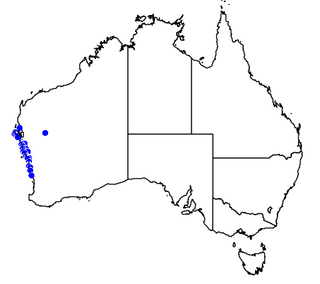
Commersonia borealis is a species of flowering plant in the family Malvaceae and is endemic to the southwest of Western Australia. It is a low growing, spreading shrub with egg-shaped to oblong leaves, and white, yellow and cream-coloured flowers.

Androcalva rosea, commonly known as Sandy Hollow commersonia, is a small endangered shrub with pink flowers and prostrate trailing branches. It is only known from four locations in the Hunter Valley of New South Wales.
Androcalva cuneata is a species of flowering plant in the family Malvaceae and is endemic to the south-west of Western Australia. It is a low, spreading, densely hairy shrub that sometimes forms suckers and has wedge-shaped leaves and clusters of 5 to 15 pink flowers.

Androcalva loxophylla is a species of flowering plant in the family Malvaceae and is endemic to northern Australia. It is a shrub with spreading or low-lying branches, oblong to broadly elliptic leaves and clusters of 4 to 20 yellow flowers.
Commersonia grandiflora is a species of flowering plant in the family Malvaceae and is endemic to the south of Western Australia. It is an erect, open shrub with hairy, egg-shaped to elliptic leaves, and white or cream-coloured flowers.
Androcalva argentea is a species of flowering plant in the family Malvaceae and is endemic to Queensland. It is a tall shrub that forms suckers from rhizomes and has silvery branchlets and leaves, the leaves egg-shaped with wavy edges and serrated, and dense clusters of 10 to 30 white to cream-coloured flowers.
Androcalva beeronensis is a species of flowering plant in the family Malvaceae and is endemic to Queensland. It is a shrub that forms suckers from rhizomes and has branchlets and leaves covered with soft, golden hairs, the leaves egg-shaped to lance-shaped with toothed edges, and clusters of 9 to 24 cream-coloured to white flowers.

Androcalva crispa, commonly known as crisped leaf commersonia, is a species of flowering plant in the family Malvaceae and is endemic to the south-west of Western Australia. It is a prostrate shrub that forms suckers from rhizomes and has densely new growth, clusters of lobed, egg-shaped or oblong leaves with wavy, serrated edges, and groups of white and pinkish-purple flowers.
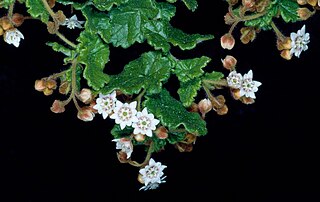
Androcalva gaudichaudii is a species of flowering plant in the family Malvaceae and is endemic to the far west of Western Australia. It is a low, dense shrub that forms suckers and has broadly oval leaves with a heart-shaped base, and clusters of 2 to 11 white flowers.
Androcalva inglewoodensis is a species of flowering plant in the family Malvaceae and is endemic to south-eastern Queensland. It is a spreading, prostrate shrub that has hairy young branchlets, egg-shaped to elliptic leaves with irregularly serrated edges, and small groups of white to cream-coloured flowers.
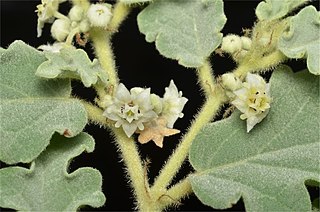
Androcalva leichhardtii is a species of flowering plant in the family Malvaceae and is endemic to central Queensland. It is a small shrub with hairy new growth, wrinkled, egg-shaped to lance-shaped leaves with irregular serrations on the edges, and small groups of yellow flowers.
Androcalva leiperi, also known as Leiper's commersonia, is a species of flowering plant in the family Malvaceae and is endemic to a restricted part of south-east Queensland. It is an erect or prostrate shrub that has brown bark, lance-shaped leaves with 4 to 7 pairs of rounded serrations on the edges, and groups of 3 to 12 white flowers.

Androcalva multiloba is a species of flowering plant in the family Malvaceae and is endemic to the Eyre Peninsula of South Australia. It is a dwarf shrub with densely hairy, irregularly serrated, egg-shaped leaves, and up to 5 white and red flowers arranged opposite leaf axils or on the ends of branches.
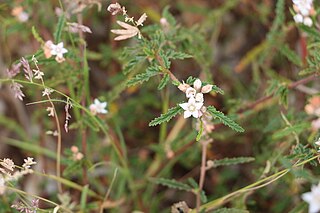
Androcalva pedleyi is a species of flowering plant in the family Malvaceae and is endemic to south-eastern Queensland. It is low, spreading or prostrate shrub that forms suckers and has softly-hairy new growth, linear to lance-shaped leaves with lobes on the edges, and groups of 7 to 10 white, later pink flowers.
Androcalva perkinsiana, commonly known as headland commersonia, is a species of flowering plant in the family Malvaceae and is endemic to a restricted part of central eastern Queensland. It is a small, erect shrub with hairy young branchlets, oblong or lance-shaped leaves with 5 to 11 pairs of small serrations on the edges, and groups of 3 to 4 pale purple flowers.
Androcalva reticulata is a species of flowering plant in the family Malvaceae and is endemic to north-eastern Queensland. It is a low shrub that forms suckers, its new growth covered with star-shaped hairs, and has egg-shaped leaves with irregular teeth on the edges, and groups of two to six red flowers.
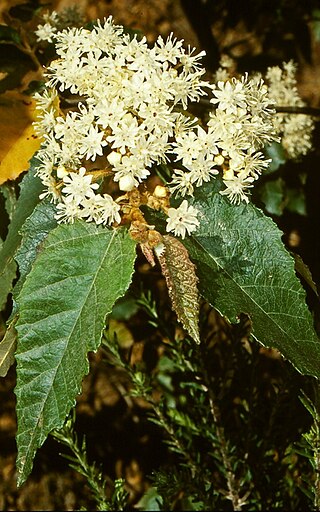
Androcalva rossii, commonly known as native hemp, is a species of flowering plant in the family Malvaceae and is endemic to south-eastern Australia. It is spindly shrub or small tree that forms suckers, its branchlets covered with star-shaped hairs, and has egg-shaped leaves with irregular teeth on the edges, and groups of 18 to 60 white or cream-coloured flowers.













